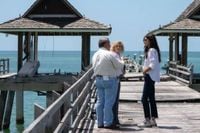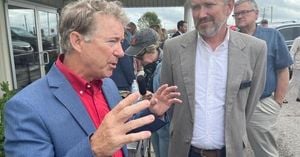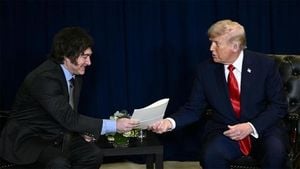For months, communities battered by natural disasters across America have been crying out for help, only to find the wheels of federal aid grinding painfully slow. But in Naples, Florida—a wealthy enclave on the Gulf Coast—things suddenly shifted into high gear. Homeland Security Secretary Kristi Noem, who oversees the Federal Emergency Management Agency (FEMA), is now facing tough questions over whether political favoritism influenced her decision to fast-track over $11 million in federal funds to rebuild the city’s historic pier, which was heavily damaged by Hurricane Ian in 2022.
According to ProPublica, city officials in Naples had been scrambling for months to secure disaster relief, navigating a maze of regulations and staff turnover that left their prized pier in bureaucratic limbo. “These agencies are undergoing significant reorganizations and staff reductions,” one city official lamented in early August, citing the Trump administration’s wave of federal layoffs as a key reason for the backlog. But the stalemate broke almost overnight after a major political donor with ties to Noem stepped in.
Text messages and emails obtained by ProPublica reveal that Naples Mayor Teresa Heitmann, frustrated by the lack of progress, reached out in August 2025 to Dr. Sinan Gursoy, a local cardiologist who had donated at least $25,000 to Noem’s 2022 gubernatorial campaign. Heitmann’s text was blunt: “FEMA is holding us up. Kristi Noem could put some fire under the FEMA employees slacking.” Gursoy replied, “Okay. I will get on it.” Within days, he had contacted Noem directly and told the mayor to expect a call from Noem’s “FEMA fixer.”
Just two weeks later, FEMA staffers were singing a different tune. “Per leadership instruction, pushing project immediately,” a representative wrote in an email reviewed by ProPublica. Another city official celebrated, “We are now at warp speed with FEMA.” The $11 million project, which had been stalled for months, was suddenly greenlit, leapfrogging other communities still waiting for relief.
Noem herself flew to Naples on a government plane at the end of August, touring the pier with Mayor Heitmann and later dining with Gursoy at the upscale French restaurant Bleu Provence. She posted photos from the visit on Instagram and didn’t mince words about the previous administration’s failures: “They couldn’t even get permission to remove the old pier. I saw this failure first-hand today with Mayor Heitmann and Gary Young, and now the project is back on track. Americans deserve better than years of red tape and failed disaster responses.”
The optics of the situation have drawn sharp criticism. As RawStory and The Independent reported, other communities hit by disasters—like those in central Texas and North Carolina—have faced excruciating waits for federal assistance. Many officials, including North Carolina Senator Ted Budd, have pointed the finger at Noem’s new policy requiring her personal sign-off on all FEMA expenses over $100,000. “Pretty much everything Helene-related is over $100,000. So they’re stacking up on her desk waiting for her signature,” Budd told the press this month. During the summer’s deadly Texas floods, it reportedly took days to deploy search-and-rescue teams because Noem hadn’t signed off on them, according to CNN.
Critics argue that Noem’s tight grip on FEMA spending has created a bottleneck, giving her enormous discretion over who gets help—and who waits. “Noem’s actions in Naples suggest the injection of political favoritism into an agency tasked with saving lives and rebuilding communities wiped out by disaster,” ProPublica wrote. Jeffrey Schlegelmilch, director of the National Center for Disaster Preparedness at Columbia University, told the outlet, “I’ve not heard of anything this egregious—a donor calling up and saying I need help and getting it, while others may be getting denied assistance or otherwise waiting in line for help that may or may not come.”
The controversy is further complicated by the presence of Corey Lewandowski, Noem’s top adviser and de facto chief of staff at DHS. Property records show Lewandowski owns a home near the Naples pier. Media reports have suggested a romantic link between Noem and Lewandowski, though both deny it. Lewandowski told ProPublica he was not involved in the pier decision and was not in Naples during Noem’s visit.
Defending Noem, Department of Homeland Security spokesperson Tricia McLaughlin insisted the Secretary’s actions were above reproach. “This has nothing to do with politics: Secretary Noem also visited Ruidoso, NM, at the request of a Democrat governor and has been integral in supporting and speeding up their recovery efforts,” McLaughlin told KELOLAND News. She called criticism of Noem’s visit to the pier “bizarre as she works to fix this issue for more than 1 million visitors that used to visit the pier.” McLaughlin also disputed the reported $11 million figure, claiming the pier project cost only $2 million, though local reporting from the Naples Press noted $11-12 million in federal funding, including $11.4 million from FEMA.
For her part, Noem has denied that her policies have caused delays elsewhere, arguing that her oversight saves taxpayer money. “Every day I get up and I think, the American people are paying for this, should they?” she said recently. “And are these dollars doing what the law says they should be doing? I’m going to make sure that they go there.”
Still, the sequence of events in Naples—months of gridlock, a donor’s intervention, and a sudden flood of federal money—has left many observers uneasy. The city, which has become a magnet for Republican fundraisers and wealthy donors, is no stranger to political influence. State credit card records show Noem visited Naples at least ten times during her last four years as South Dakota governor.
Mayor Heitmann, for her part, made no secret of her gratitude. On August 29, she posted on social media, “Noem took immediate action when I reached out to ask for help.” But the mayor also acknowledged she hadn’t asked Noem to visit in person—“I didn’t ask her to come, but she showed up,” she told local news. “I was very impressed.”
As the dust settles, the Naples pier stands as both a symbol of resilience and a lightning rod for debate over how disaster aid is distributed in America. The questions swirling around Noem, FEMA, and the role of political donors are unlikely to fade soon—especially as communities nationwide continue to wait, and watch, for their own chance at recovery.





